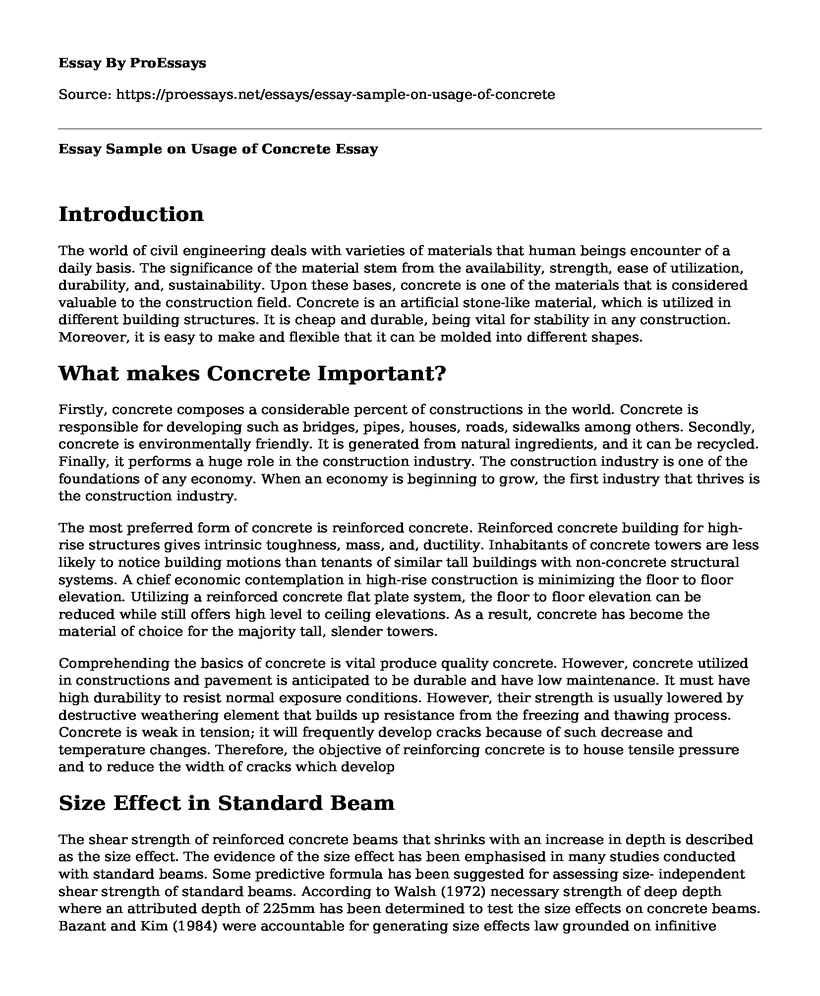Introduction
The world of civil engineering deals with varieties of materials that human beings encounter of a daily basis. The significance of the material stem from the availability, strength, ease of utilization, durability, and, sustainability. Upon these bases, concrete is one of the materials that is considered valuable to the construction field. Concrete is an artificial stone-like material, which is utilized in different building structures. It is cheap and durable, being vital for stability in any construction. Moreover, it is easy to make and flexible that it can be molded into different shapes.
What makes Concrete Important?
Firstly, concrete composes a considerable percent of constructions in the world. Concrete is responsible for developing such as bridges, pipes, houses, roads, sidewalks among others. Secondly, concrete is environmentally friendly. It is generated from natural ingredients, and it can be recycled. Finally, it performs a huge role in the construction industry. The construction industry is one of the foundations of any economy. When an economy is beginning to grow, the first industry that thrives is the construction industry.
The most preferred form of concrete is reinforced concrete. Reinforced concrete building for high-rise structures gives intrinsic toughness, mass, and, ductility. Inhabitants of concrete towers are less likely to notice building motions than tenants of similar tall buildings with non-concrete structural systems. A chief economic contemplation in high-rise construction is minimizing the floor to floor elevation. Utilizing a reinforced concrete flat plate system, the floor to floor elevation can be reduced while still offers high level to ceiling elevations. As a result, concrete has become the material of choice for the majority tall, slender towers.
Comprehending the basics of concrete is vital produce quality concrete. However, concrete utilized in constructions and pavement is anticipated to be durable and have low maintenance. It must have high durability to resist normal exposure conditions. However, their strength is usually lowered by destructive weathering element that builds up resistance from the freezing and thawing process. Concrete is weak in tension; it will frequently develop cracks because of such decrease and temperature changes. Therefore, the objective of reinforcing concrete is to house tensile pressure and to reduce the width of cracks which develop
Size Effect in Standard Beam
The shear strength of reinforced concrete beams that shrinks with an increase in depth is described as the size effect. The evidence of the size effect has been emphasised in many studies conducted with standard beams. Some predictive formula has been suggested for assessing size- independent shear strength of standard beams. According to Walsh (1972) necessary strength of deep depth where an attributed depth of 225mm has been determined to test the size effects on concrete beams. Bazant and Kim (1984) were accountable for generating size effects law grounded on infinitive sequences.
Size Effect in Deep Beams
Several researchers studied the effect size of a reinforced concentrate beam. Kanl (1967) asserts the presence of robust size effect on the ultimate shear strength of RC beams. Almost 405 the strength shrinkage was observed when the beam gravity was elevated from 300mm to 1200mm. A similar study was conducted by Shioya et al. (1989) which they found an extended reduction of 25% of the shear strength when the depth of beam was increased from 300mm to 1200mm. As much as the size effect has been observed in a broad beam that has been reinforced with shear; a formula to predict the increase in size effect of reinforced concrete beams is missing. Therefore, this study seeks to derive a simple equation that can be used to predict the size effect of a reinforced beam. The variables that will be used for this experimental program are the amount of longitudinal steel reinforcement, member depth, and, concrete strength. The impacts of these variables on the shear strain at failure of the concrete will be analysed.
References
Bazant, Z. P., & Kim, J. K. (1984). Size effect in shear failure of longitudinally reinforced beams. Journal of the American Concrete Institute, 81(5), 456-468. Retrieved from: http://koasas.kaist.ac.kr/bitstream/10203/7599/1/1984-Size%20Effect%20in%20Shear%20Failure%20of%20Longitudinally%20Reinforced%20Beams.pdf
Kani, G. (1967, March). How safe are our large reinforced concrete beams?. In Journal Proceedings (Vol. 64, No. 3, pp. 128-141).Retrieved from:
https://www.concrete.org/publications/internationalconcreteabstractsportal/m/details/id/7549
Shioya, T., Iguro, M., Nojiri, Y., Akiyama, H., & Okada, T. (1990). Shear strength of large reinforced concrete beams. Special Publication, 118, 259-280. Retrieved from: https://www.concrete.org/publications/internationalconcreteabstractsportal/m/details/id/2978
Sherwood, E. G., Lubell, A. S., Bentz, E. C., & Collins, M. P. (2006). One-way shear strength of thick slabs and wide beams. ACI Structural Journal, 103(6), 794. Retrieved from: https://www.researchgate.net/profile/Adam_Lubell/publication/280446535_One-Way_Shear_Strength_of_Thick_Slabs_and_Wide_Beams/links/56b011ac08ae9f0ff7b29904.pdf
Cite this page
Essay Sample on Usage of Concrete. (2022, Nov 27). Retrieved from https://proessays.net/essays/essay-sample-on-usage-of-concrete
If you are the original author of this essay and no longer wish to have it published on the ProEssays website, please click below to request its removal:
- The Environmental Effects of Oil and Natural Gas Extraction Through Hydraulic Fracturing
- Paper Example on General Motors and the Ignition Switch Recalls
- Critical Article Analysis Essay on Vision 2030
- What Should Ray Include in His Job Description for the Director of Engineering Position? - Essay Sample
- Essay Example on Hazards at an Oil Company: Identifying Risks & Solutions
- Essay Sample on Gasoline: Demand Inelastic When Supply High/Low
- Paper Example on Analysis of Helmet Lattice Liner Performance on Mitigating TBI







